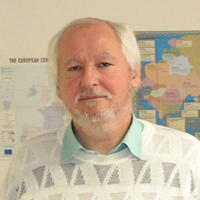Topic: Metastable Phases and Nanocrystalline Forming Ability (Nfa) of Melt–quenched Ni-rich (Zr,Hf)–Ni Alloys
Speaker: I. Bakonyi
Wigner Research Centre for Physics, Hungarian Academy of Sciences. Budapest, Hungary
Time: 10:30-12:00, Monday, Sep.26, 2016
Venue: Room 468, Lee Hsun Building, IMR CAS
Welcome to attend!
Abstract:
While staying at MPI Stuttart in the early 1990s, I was interested in getting amorphous Ni-Zr and Ni-Hf alloys around 90. at.% Ni by melt-spinning. These compositions are in the vicinity of a narrow eutectic and, therefore, glass-forming ability is fairly small. In order to increase the cooling rate, He gas with a low pressure (ca. 1 mbar) was entered into the melt-quenching chamber [1]. Depending on the ribbon thickness and alloy composition, amorphous and crystalline ribbons were obtained [1-2].
Structural studies by XRD and TEM on the crystalline melt-quenched ribbons revealed that they consisted of a single phase: either a bcc-Ni(Zr) or bcc-Ni(Hf) solid solution [2] or a Ni5Hf phase with the excess Ni atoms substituted on the Hf sites [2-5].
In the present talk, I will give details about the structure of these melt-qeunched Ni-rich metastable phases of the Ni-Zr and Ni-Hf systems. On the basis of the well-known TTT (time temperature transformation) diagrams and of the experimental findings, the formation sequence of the equilibrium and the metastable phases during the melt-quenching process will be schematically described for these Ni-rich alloys [6].
After discussing the general conditions for the glass-forming ability (GFA), some considerations will be presented to give some guidelines, based on the experimental findings on the Ni89Hf11 alloy, for the formation of a single-phase nanocrystalline alloy phase in a single-step melt-quenching process [4]. Along these lines, we have also succeeded in getting a single-phase nanocystalline FeHf2 alloy by melt-quenching [7]. For both the Ni-Hf and Fe-Hf melt-quenched nanocrystalline alloys, an extension of the homogeneity range of the compound phases was observed with respect to the equilibrium, microscrystalline state.
The general conditions for the nanocrystalline-forming ability (NFA) can be summarized as follows:
♦ Prospective candidates with good NFA are alloys with stoichiometric compositions where the crystalline state can be formed with homogenenous nucleation over the entire volume without the need for phase separation (i.e., for long-range diffusion)
♦ A critical cooling rate window should be established experimentally: the cooling rate must be below that required for amorphous state formation, but should be sufficiently high to avoid grain growth.
The significance of establishing the general conditions for NFA lies in the following features:
→ Preparation of large quantities of porosity-free single-phase nanocrystalline alloys in a single-step MQ process
→ Possibility of preparing nanocrystalline alloys with previously unaccessible compositions
→ Due to the extended solubility, a series of nanocrystalline alloys with the same crystal structure can be prepared with different compositions
References:
[1] I. Bakonyi et al., Z. Metallkde 86, 619 (1995)
[2] Á. Cziráki, ...., I. Bakonyi, J. All. Comp. 210, 135 (1994)
[3] K. Lu, Z.F. Dong, I. Bakonyi, Á. Cziráki, Acta Metall. Mater. 43, 2641 (1995)
[4] I. Bakonyi and Á Cziráki, NanoStructured Mater. 11, 9 (1999)
[5] J. Gubicza et al., J. Nanosci. Nanotechnol. 1, 343 (2001)
[6] I. Bakonyi, Int. J. Mater. Res. (Z. Metallkde) 97, 471 (2006))
[7] Á. Révész, …, I. Bakonyi, Z. Metallkde. 96, 974 (2005)
Biography:
 Dr. Imre Bakonyi received his C.Sc. and D.Sc. from the Hungarian Academy of Sciences (HAS) and his Ph.D. from the Eötvös University in Budapest, Hungary. He has served as the Head of Metals Research Department at HAS and is currently a scientific advisor with the Academy. Dr. Bakonyi has received the Research Awards of Physics Research Centre of HAS, Zoltan Gyulai Award, and the Annual Publication Awards of ISSPO. Dr. Bakonyi has a total of nearly 200 research papers in English, 1 patent, 2 book chapters, and about 2,600 citations to published papers; his research expertise is in the preparation, thermal stability, atomic and electronic structure, electrical transport and magnetic properties of amorphous, nanocrystalline, multilayered and other metastable metallic phases, metal hydrides. His current focus of research is the giant magnetoresistance (GMR) in electrodeposited multilayers and multilayered nanowires.
Dr. Imre Bakonyi received his C.Sc. and D.Sc. from the Hungarian Academy of Sciences (HAS) and his Ph.D. from the Eötvös University in Budapest, Hungary. He has served as the Head of Metals Research Department at HAS and is currently a scientific advisor with the Academy. Dr. Bakonyi has received the Research Awards of Physics Research Centre of HAS, Zoltan Gyulai Award, and the Annual Publication Awards of ISSPO. Dr. Bakonyi has a total of nearly 200 research papers in English, 1 patent, 2 book chapters, and about 2,600 citations to published papers; his research expertise is in the preparation, thermal stability, atomic and electronic structure, electrical transport and magnetic properties of amorphous, nanocrystalline, multilayered and other metastable metallic phases, metal hydrides. His current focus of research is the giant magnetoresistance (GMR) in electrodeposited multilayers and multilayered nanowires.



